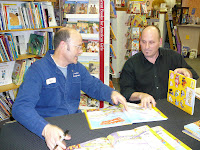The moral of this story is, "Let them talk during read aloud."
In reading workshop, we've been working on finding the themes/morals/lessons that an author may or may not intend for us to extract or infer from his/her story.
In read aloud
the other day, we had a bunch of fun finding silly themes/morals/lessons in 3 picture books.

How could we not read parts of
Squids Will Be Squids by Jon Scieszka and Lane Smith? Besides remembering or learning what a fable is, we also had a great discussion about why Scieszka can get away with writing a run-on sentence a whole paragraph long (in the Serious Historical Foreword), and fourth graders can't. Or should I say...and fourth graders
are required to chop it into sentences, because some of my students CAN (and do) write whole paragraphs and pages without punctuation!
I read "Grasshopper Logic," and the conversation turned to the other things that are not good to say to a "hopping mad Grasshopper Mom."
Next, I read "He who..." because I knew they would be able to fill in the moral on their own. They could. ("He who smelt it...")
The last one I read, my own personal favorite of the entire collection, was "Straw and Matches." They started getting the double entendres and puns from the very beginning: "It was the end of summer vacation. Straw had done everything he could think of. He was bored. So he went over to play with someone he had been warned to stay away from." They groaned with laughter when they heard the moral and knew it was both about choosing one's friends and about playing with fire.
I didn't read any more from "Squids Will Be Squids," because my goal was for them to want to read more on their own. (It worked.)

Next came Jane Wattenberg's version of
Henny-Penny. (How did it happen that this book got so old so fast! It's from seems-like-yesterday, but in-reality 2000!)
I read the whole book, because how often you get to shout, "CHICKABUNGA!" during a regular school day?
I swear, this class found more in Wattenberg's illustrations than any class ever! Not only that, but they could identify nearly every world landmark the flock of fowl visits in the course of the story. (Only the Coliseum and Stone Henge stumped them.) And one student knew what a cave would be like it it was "dank." WOW!
A few morals of this story? "Don't leave home until you lay your egg." "Stranger Danger -- Don't follow someone you don't know into a dark, dank cave." "Check to see what hit you in the head before you run off to tell the king the sky is falling." And here's mine: "Sometimes it's best to be the last one in the cave, because you might be the only one who makes it out!"

We ended with
The Wolf Who Cried Boy by Bob Hartman. They knew the moral before I ever started reading, so this one, too, was more about the puns and word play. (Lamburgers, Sloppy Does, Chocolate Moose, Boy Chops, Three-Pig Salad, Baked Boy-tato, Boys-n-Berry Pie...it goes on and on.)
After read aloud was over, one of my students asked if I had The Boy Who Cried Wolf. Sadly, I only have the variant. I will have to correct that soon. A day later, the same student came back from the book fair with The Dog Who Cried Wolf.
I love it when I get them started and they keep going on their own!








